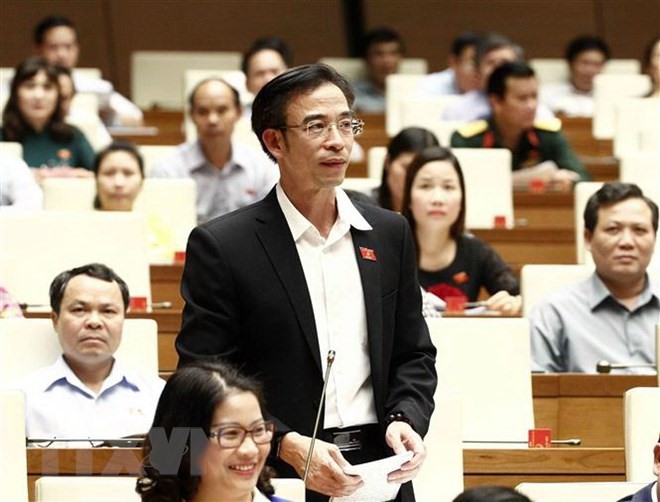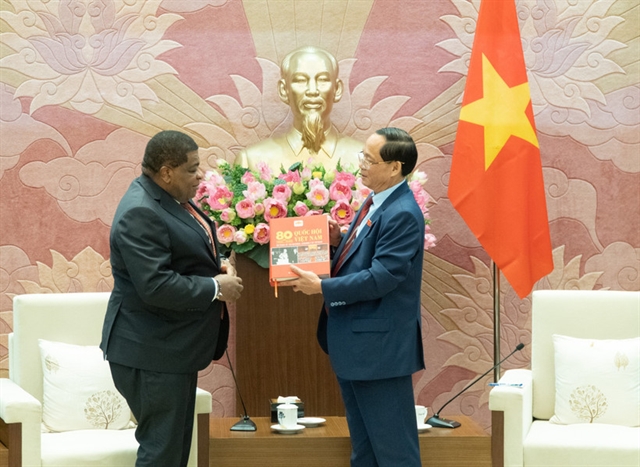 Politics & Law
Politics & Law

Ministers faced a great deal of questions on Tuesday as the National Assembly opened its first day of cabinet hearing.
 |
| Deputy Nguyễn Quang Tuấn from Hà Nội. — VNA/VNS Photo Văn Điệp |
HÀ NỘI — Ministers faced a great deal of questions on Tuesday as the National Assembly opened its first day of cabinet hearing.
The NA in its mid-term gathering tried out a new way of conducting the hearings, during which the deputies were no longer framed into a fixed timeline to question a particular minister or cabinet leader but they were free to spontaneously point to any officials and demand an answer regarding their particular issues.
That meant that Tuesday’s hearing – the first out of the three consecutive days dedicated solely to Q&As - did not have a specific focus but multiple topics that ranged from the current status of the blacklisted State-owned enterprises to criminals on the run.
‘Pay their dues’
Responding to a question on the 12 mega-projects invested by the Ministry of Industry and Trade that had sustained losses of trillions of đồng, minister Trần Tuấn Anh took the stage to brief the NA on the latest updates.
Anh said that two out of 12 projects – the Việt Nam-China Steel Factory and the Hải Phòng Diammonium Phosphate (DAP) Fertiliser Factory – had already resumed operations and started turning a profit.
The Government would consider removing those two from the blacklist, he said.
Four other projects, including Hà Bắc Nitrogenous Fertiliser and Chemicals, Ninh Bình Nitrogenous Fertiliser, Lào Cai DAP Fertiliser and Dung Quất Shipbuilding Industry Company, were getting back in the game “step by step”. Their losses remained very high, the minister said, due to their massive loans and interests, so the authorities would still have to pay a close attention to them.
Two projects that had their operations suspended are back in business, which is the first step for the Government to restructure and divest when the time comes, according to Anh.
The Dung Quất and Bình Phước Bio-Ethanol factories were finishing up the last stages to resume operations while the Government might consider letting Phú Thọ Ethanol go bankrupt due to its poor location and inefficient business model.
The last project, the Thái Nguyên Iron and Steel Corporation, was still involved in disputes with its Chinese contractors and the ministry was working to solve them, the minister said.
"Our ultimate goal is to minimise losses and preserve the State’s capital," Anh said.
"In the meantime, we are determined to make those responsible (for the losses) pay their dues."
The minister reported that central and local inspectors have scrutinised all 12 projects, of which the files from four projects were handed to the police for official investigation into wrongdoings. Two have been prosecuted so far.
Criminals on the loose
Acknowledging that more than 11,700 wanted criminals were still on the loose, Minister of Public Security Tô Lâm admitted the dangers to society as well as the system’s failure to punish wrongdoings and enforce the law.
His solution was to tighten residential management to "closely track people and households at a local level.”
The Ministry of Public Security was also working on a new kind of anti-counterfeit identification document, Lâm said.
"We used to have a task force to chase wanted suspects but it was unable to keep up with such a large number of criminals," he said. "So we have decided to dismiss the task force and instead make the police unit responsible for (the investigation of) the criminal also in charge of finding them."
Hòa Lạc in motion
Deputy Prime Minister Vũ Đức Đam took the chance to defend the colossal projects in Hà Nội’s Hòa Lạc area when he was questioned about the projects’ feasibility following a 20-year-plus delay.
According to Đam, the Government approved plans to build three projects, namely the Hòa Lạc Hi-tech Park, the Hà Nội National University Complex and the Culture and Tourism Village of Vietnamese Ethnic Groups decades ago but slow investment stalled construction.
Things started to change at the Hòa Lạc Hi-tech Park in 2014 and 2015 when the Government and Hà Nội authorities decided to accelerate land clearance for the site.
“There was only 200ha out of 1,500ha yet to be cleared for construction,” he said. “The Government has also found funding of US$200 million from Japanese ODA to build the infrastructure for three separate complexes of Industry, Research & Development and Education.”
The industry complex was so far very “crowded”, Đam said, as it had attracted more than 66 projects worth over $3 billion. The R&D complex was in the process of selecting projects with cutting-edge technologies while the FPT University and the University of Science and Technology of Hà Nội - or the Việt Nam-France University - already had their campuses built in Hòa Lạc.
“The Hòa Lạc Hi-tech Park has overcome its most difficult period and will perform very well,” the Deputy PM told the NA.
Regarding the Hà Nội National University complex, capital shortage remained the biggest challenge when only a few dozens of billions of đồng had been poured into the project over the last few years despite the much needed investment of roughly $2 billion.
The Culture and Tourism Village of Vietnamese Ethnic Groups project faced the same issue as the Government could only meet 36 per cent of the investment demand.
Đam said that Prime Minister Nguyễn Xuân Phúc had already asked the Ministry of Planning and Investment to look for sources of funding to pump into those two projects. — VNS




